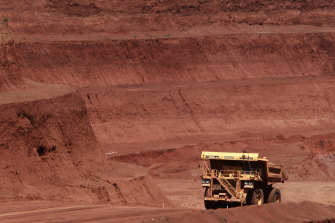Rio Tinto warns Omicron may hit top export iron ore as WA reopens
Mining giant Rio Tinto has warned the threat of widespread Omicron infections and staff absenteeism once Western Australia opens its border to the rest of the country could worsen the state’s labour crunch and hit iron ore output.
The top producer of iron ore, the nation’s biggest export, on Tuesday reported a drop in shipments of the steel-making raw material in the December quarter amid protracted pandemic-related challenges such as supply chain disruptions and a shortage of skilled workers needed to commission new mines and mine expansions.

While much of the labour squeeze has been attributed to WA’s hard border with the rest of Australia limiting movement and availability of fly-in, fly-out staff, the WA government’s plan to relax restrictions on February 5 is not likely to bring large numbers of workers back immediately and has stoked concerns within the industry that the situation is likely to worsen before it improves.
Rio Tinto warned its target to increase iron ore output from WA in 2022 would be contingent on the impact of the spread of Omicron, the COVID-19 variant that has caused crippling workforce shortages in Australia and around the world.
“Our guidance assumes development of the pandemic does not lead to government-imposed restrictions and widespread protracted cases related to new, highly contagious variants with high severity, which could result in a significant number of our production-critical workforce and contractor base being unable to work due to illness and/or isolation requirements,” Rio Tinto said.
The mining giant in December cut 5 million tonnes from the bottom line of its iron ore target, citing a “tight labour market” in WA’s Pilbara mining heartland, which had hampered new iron ore mine developments including the $US2.6 billion Gudai-Darri project. Production had also slowed across Rio’s operations due to above-average rainfall and an enhanced focus on Indigenous heritage issues following its ill-fated destruction of the 46,000-year-old Juukan Gorge rock shelters in 2020, which devastated the land’s traditional owners, plunged the company into crisis and led to the resignations of its former chief executive and chairman.
Rio’s new chief executive, Jakob Stausholm, on Tuesday said operating conditions remained “challenging” including due to prolonged pandemic-related disruptions across its operations.
Analysts said Rio Tinto’s mine-capacity issues were likely to “weigh again in 2022” at the same time as the iron ore price came under pressure.
“Although iron ore prices have provided the shares some solace in recent weeks, we continue to see a challenging outlook for iron ore over the course of 2022,” Royal Bank of Canada analyst Kaan Peker said.
Iron ore, which steel-makers heat with coal at high temperatures to churn out liquid metal, is Australia’s biggest export, accounting for a record $150 billion in 2021.
During the year, the price of iron ore rallied to an unprecedented $US230 a tonne, underpinned by an aggressive infrastructure-focused building blitz in China, which fuelled enormous demand for steel at the same time as drawn-out supply disruptions dragged on iron ore mines in Brazil. The boom delivered huge profits and bumper dividends for shareholders of top Australian miners BHP, Rio Tinto and Fortescue, and helped bolster the nation’s finances during the depths of the COVID-19 crisis.
However, the iron ore price fell sharply in the second half of the year as Beijing deepened cuts across its steel mills to reduce emissions from one of its worst-polluting industries and global supply began to pick up.
While China’s steel production rose again in December to its highest level since August and helped bring iron ore back above $US120 a tonne, investment bank UBS said it remained “cautious” on the commodity’s outlook.
“We expect demand to be weak and supply to lift in 2022,” UBS analyst Myles Allsop said.
Most Viewed in Business
Source: Thanks smh.com